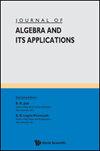半减半域算术
IF 0.6
3区 数学
Q3 MATHEMATICS
引用次数: 0
摘要
如果$(S,+)$和$(S\setminus\{0\}, \cdot)$这两对半群是交换半群和可取消半群,那么一个积分域的子集$S$被称为半域。$S$ 的乘法扩展到差集 $\mathscr{G}(S)$,把 $\mathscr{G}(S)$ 变成了一个积分域。在本文中,我们将研究半减半域的算术(即对于每一个 $s \in S$ 或 $-s \in S$ 的半域 $S$)。具体来说,我们提供了半减法半域成为原子半域、满足主ideals的升链条件、成为有界因式分解半域以及成为有限因式分解半域的必要条件和充分条件,这些条件是对具有唯一因式分解这一性质的后续放宽。此外,我们还介绍了因式半域和半因式半域的特征。在整篇文章中,我们举例说明了半减半域的算术方面。本文章由计算机程序翻译,如有差异,请以英文原文为准。
Arithmetic of Semisubtractive Semidomains
A subset $S$ of an integral domain is called a semidomain if the pairs $(S,+)$ and $(S\setminus\{0\}, \cdot)$ are commutative and cancellative semigroups with identities. The multiplication of $S$ extends to the group of differences $\mathscr{G}(S)$, turning $\mathscr{G}(S)$ into an integral domain. In this paper, we study the arithmetic of semisubtractive semidomains (i.e., semidomains $S$ for which either $s \in S$ or $-s \in S$ for every $s \in \mathscr{G}(S)$). Specifically, we provide necessary and sufficient conditions for a semisubtractive semidomain to be atomic, to satisfy the ascending chain condition on principals ideals, to be a bounded factorization semidomain, and to be a finite factorization semidomain, which are subsequent relaxations of the property of having unique factorizations. In addition, we present a characterization of factorial and half-factorial semisubtractive semidomains. Throughout the article, we present examples to provide insight into the arithmetic aspects of semisubtractive semidomains.
求助全文
通过发布文献求助,成功后即可免费获取论文全文。
去求助
来源期刊
CiteScore
1.50
自引率
12.50%
发文量
226
审稿时长
4-8 weeks
期刊介绍:
The Journal of Algebra and Its Applications will publish papers both on theoretical and on applied aspects of Algebra. There is special interest in papers that point out innovative links between areas of Algebra and fields of application. As the field of Algebra continues to experience tremendous growth and diversification, we intend to provide the mathematical community with a central source for information on both the theoretical and the applied aspects of the discipline. While the journal will be primarily devoted to the publication of original research, extraordinary expository articles that encourage communication between algebraists and experts on areas of application as well as those presenting the state of the art on a given algebraic sub-discipline will be considered.

 求助内容:
求助内容: 应助结果提醒方式:
应助结果提醒方式:


